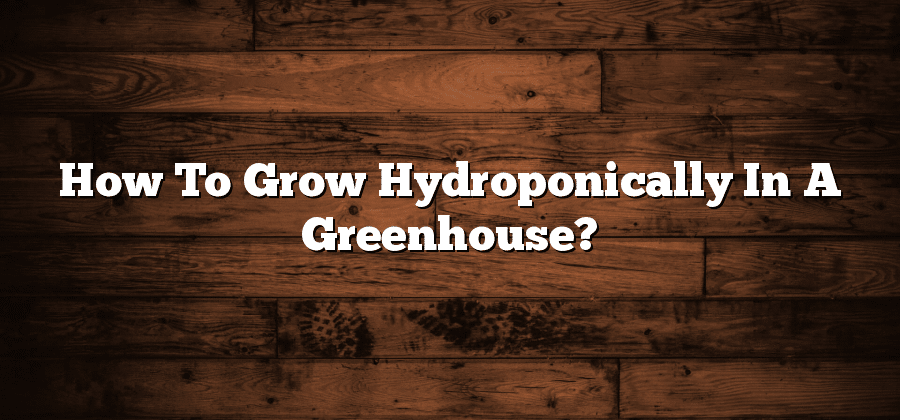Choosing the Right Greenhouse Structure
When it comes to choosing the right greenhouse structure, there are several factors to consider. Firstly, size is a crucial aspect to think about. Assess your available space and determine how much area you can dedicate to your greenhouse. Consider the plants you plan to grow and their space requirements. It’s important to select a greenhouse that offers ample room for your plants to grow and thrive.
Another important factor to consider is the material of the greenhouse structure. The most common options include glass, polycarbonate, and polyethylene. Glass greenhouses are known for their durability and longevity, providing excellent light transmission. Polycarbonate structures are lightweight and offer good insulation, making them suitable for areas with extreme weather conditions. Polyethylene greenhouses are affordable and easy to install, making them a popular choice for beginners. Evaluate the advantages and disadvantages of each material to determine which one best suits your needs and budget.
Ultimately, choosing the right greenhouse structure is essential for the success of your plants. By carefully considering factors such as size and material, you can create an optimal growing environment that will support healthy growth and maximize your yield.
Selecting the Ideal Hydroponic System
Hydroponics is a unique and innovative method of growing plants without the use of soil. With this system, plants receive the essential nutrients they need through a nutrient-rich water solution. Selecting the ideal hydroponic system is a critical step in ensuring optimal plant growth and achieving higher yields.
One of the key factors to consider when choosing a hydroponic system is the size of the system and the space available. Whether you have a small backyard or a large commercial greenhouse, there are systems suited for every scale. Small-scale systems like the Nutrient Film Technique (NFT) or the Deep Water Culture (DWC) are perfect for beginners or hobby gardeners. On the other hand, larger systems like the Ebb and Flow or the Drip System are better suited for commercial growers who have a larger space and higher production demands. By assessing your available space, you can determine which hydroponic system will be the most suitable for your needs.
Understanding Essential Nutrients for Hydroponic Growth
Hydroponic growth relies on a carefully balanced supply of essential nutrients to ensure optimal plant development and yield. Unlike traditional soil-based farming, where plants can access nutrients from the surrounding soil, hydroponic systems require a precise nutrient solution to be delivered directly to the plant roots. The right combination of essential nutrients is crucial for promoting healthy growth and maximizing crop productivity.
There are several essential nutrients that hydroponic plants require for optimal growth. These include macronutrients such as nitrogen (N), phosphorus (P), and potassium (K), which are needed in large quantities for plant development. Additionally, there are micronutrients like iron (Fe), manganese (Mn), and copper (Cu) that are required in smaller amounts but are equally vital for plant health. Each nutrient plays a unique role in the growth and development of hydroponic plants, and it is essential to provide them in the right proportions and concentrations to avoid deficiencies or toxicities. Without a proper understanding of these essential nutrients and their functions, hydroponic growers risk compromising the overall health and productivity of their crops.
Managing Light and Temperature in the Greenhouse
Light and temperature play crucial roles in the success of greenhouse operations.
Firstly, light is a vital factor in the growth and development of plants in a greenhouse. The intensity and duration of light exposure directly affect the photosynthesis process. Therefore, it is essential to assess the light requirements for the specific plants being cultivated. Some crops thrive in direct sunlight, while others prefer diffused light. Greenhouse growers can achieve optimal lighting conditions by utilizing shade cloths, UV filters, or adjusting the position of the greenhouse to maximize sunlight exposure.
Similarly, maintaining suitable temperatures in the greenhouse is of utmost importance. Temperature affects the rate of plant growth, photosynthesis, and overall plant health. Consistent temperature control is crucial to prevent stress and maximize yields. Greenhouse operators can achieve this by utilizing ventilation systems, fans, or evaporative cooling techniques to regulate temperatures. Monitoring equipment such as thermostats and thermometers can help ensure that the greenhouse maintains the ideal temperature range for the chosen crops.
Maintaining Proper pH Levels in Hydroponic Solutions
Maintaining proper pH levels in hydroponic solutions is crucial for the success of your crops. pH, which stands for potential hydrogen, refers to the acidity or alkalinity of a solution. In hydroponics, maintaining the correct pH range is essential because it directly affects nutrient availability to plants.
To keep your pH levels in check, start by regularly testing your hydroponic solution using a pH meter or test kit. The optimal pH range for most hydroponic crops is between 5.5 and 6.5. Anything above or below this range can lead to nutrient deficiencies or toxicities, hindering plant growth and vitality. Adjusting pH levels can be done by adding pH adjusters, such as pH up or pH down solutions, depending on whether the solution needs to be raised or lowered. Remember to make gradual adjustments to avoid drastic pH changes that may harm your plants.






